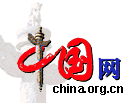|
The European Union has decided to increase quotas for Chinese textiles when 10 more nations join the union on May 1, according to the Ministry of Commerce.
The new quotas cover 37 categories of textile products which are currently under quota management among EU members but not in the ten new EU nations, according to a ministry official.
The EU will have its largest enlargement in four weeks as ten country's will join the 15-member bloc. They include the Czech Republic, Estonia, Cyprus, Latvia, Lithuania, Hungary, Malta, Poland, Slovenia and Slovakia.
The quota number is consequently adjusted so as to cover exports to the ten new members, said the official.
He said this is one of the trade compensations made by the EU as its enlargement will mean higher duties and the imposition of quotas for exports of certain products to new members.
The increased textile quota is calculated on a formula consisting of an average of Chinese exports in the last three years to the ten new members, the official said.
The added quota is a small fragment compared to the total number for the EU market, he said.
The official stressed that textile products subject to quotas shipped before May 1, 2004 but entering the new members on or after the date will be granted import authorization without quota limitation.
But Chinese exporters should provide adequate proof to the authorities, such as the bill of lading.
The official also mentioned another principle for processing trade, which is especially important for China.
"If one of the new members sends textile products to China for processing before May 1, 2004, which are then re-imported into the same member state on or after that date, those products will not be subject to quotas," he said.
The textile quota adjustment is based on the revised EU regulation on textile quotas and will be implemented among all trading partners.
China did not file a specific request to set up negotiations on the issue since textile quota limits are expected to end eight months after EU enlargement.
Under the Agreement on Textiles and Clothing, all quotas restricting textile and clothing trade between WTO members will be eliminated by December 31, 2004.
Chinese exporters of garlic and mushrooms will feel the brunt of the new regulation since the 10 new members will be forced to raise their tariffs on the two farm products to conform with EU rules.
The EU has asked China to provide details on the size of its trade in garlic and mushrooms with the new EU member states to serve as a basis for negotiations for compensation.
The EU has agreed to offer China extra quotas on garlic and mushrooms before May 1, said the EU Commissioner for Agriculture Franz Fischler, during a visit to China two weeks ago.
In addition to the existing quota, the EU will impose an autonomous quota, which refers to interim import limits provided outside the framework of the WTO.
With only weeks to go before enlargement, there may not be enough time to conclude detailed talks on compensation for China and the extra quotas will act as a preliminary measure to satisfy the Chinese side, Fischler said.
China's trade with the ten members is relatively small compared with its overall European trade.
Chinese exports to the EU totaled US$72 billion dollars, while exports to the ten new members reached just US$6 billion.
The EU is also facing demands for trade compensation from top commercial partners such as the United States and Japan.
According to WTO rules, WTO members have the right to seek compensation for any trade losses incurred as a result of less attractive terms of access to the EU than they currently have with the new members.
However, generally speaking, EU enlargement will be a good move for trade partners since a larger internal market will be offered, market access to the new members will be simplified and a substantial reduction in overall import tariffs will be seen.
Average tariff rates will decrease from 9 percent to 4 percent in the new member states.
The EU market, after enlargement, will have 450 million citizens, accounting for roughly 18 percent of world trade and contributing to more than 25 percent of the world's gross domestic product.
(China Daily April 5, 2004)
|

